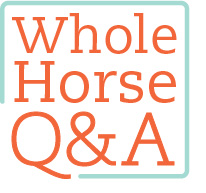Q I have a 3-year-old Arabian/Paint-cross gelding that bites at his sides several times a day. What causes this behavior, and how can I stop it?

COURTNEY STODDARD, Alabama
A Biting at the flanks or chest is known as self-mutilation. Sometimes horses that engage in this behavior also spin, buck, or kick out. The biting usually begins with just ruffling the hair, but can progress all the way to drawing blood.
We don’t know exactly how common this behavior is, though it’s common enough to have prompted specific studies. I myself have studied many horses that exhibited self-mutilating behavior. We know that horses can engage in one to multiple episodes of this biting per day, but they usually don’t do it all day long. The behavior, unless resolved or managed, can continue for years.
Biting at the flank is more common than biting the chest, and because flank-biting is also associated with colic episodes or as a reaction to other pain, there can be confusion as to what the horse is really expressing. Recently, with better diagnostic techniques, there’s evidence that many instances of this biting are related to pain. Any horse biting himself should have a thorough veterinary exam, including ultrasound. Some horses can have gastrointestinal problems for years that, though not life threatening, can cause discomfort that inspires the self-biting.
Still, some horses do engage in this behavior with no traceable evidence of pain. In those cases, it’s interesting to note that 90 percent are male, with stallions the most inclined to exhibit it. Moreover, in only about one-third of cases studied by Dr. Nicholas Dodman at Tufts University did having a stallion gelded solve the problem.

Though I’ve seen suckling foals start this behavior and progress with it to adulthood, it usually begins at sexual maturity (about age 2 in horses) and almost never later than age 4. Given that timing and the fact that stallions display self-biting far more than geldings or mares, we’re led to believe this behavior could be connected to sexual frustration. Before current sophisticated diagnostics to identify pain, we used to treat the behavior by putting a stallion in with mares, and sometimes that seemed to work.
Dr. Sue McDonnell at the University of Pennsylvania has studied this behavior and guesses that a horse may think he’s fighting with another stallion, but takes out his aggression on himself. Odor can play a role—horses sometimes sniff their own feces, then engage in a biting episode.
Do everything you can to rule out pain with your horse. After that, keep him as occupied as possible, as sometimes distractions and activity seem to decrease the biting behavior. Keep him in work, improve his social arrangement with other horses, give him plenty of turnout, and allow him to graze or forage for his meals. With diligent management, you may be able to reduce his inclination to bite himself.
KATHERINE HOUPT, VMD, PhD, DACVB
Professor Emeritus, Cornell University






